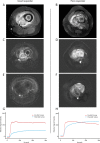Evaluation of response to neoadjuvant chemotherapy in osteosarcoma using dynamic contrast-enhanced MRI: development and external validation of a model
- PMID: 37464020
- PMCID: PMC10730632
- DOI: 10.1007/s00256-023-04402-8
Evaluation of response to neoadjuvant chemotherapy in osteosarcoma using dynamic contrast-enhanced MRI: development and external validation of a model
Abstract
Objective: To identify which dynamic contrast-enhanced (DCE-)MRI features best predict histological response to neoadjuvant chemotherapy in patients with an osteosarcoma.
Methods: Patients with osteosarcoma who underwent DCE-MRI before and after neoadjuvant chemotherapy prior to resection were retrospectively included at two different centers. Data from the center with the larger cohort (training cohort) was used to identify which method for region-of-interest selection (whole slab or focal area method) and which change in DCE-MRI features (time to enhancement, wash-in rate, maximum relative enhancement and area under the curve) gave the most accurate prediction of histological response. Models were created using logistic regression and cross-validated. The most accurate model was then externally validated using data from the other center (test cohort).
Results: Fifty-five (27 poor response) and 30 (19 poor response) patients were included in training and test cohorts, respectively. Intraclass correlation coefficient of relative DCE-MRI features ranged 0.81-0.97 with the whole slab and 0.57-0.85 with the focal area segmentation method. Poor histological response was best predicted with the whole slab segmentation method using a single feature threshold, relative wash-in rate <2.3. Mean accuracy was 0.85 (95%CI: 0.75-0.95), and area under the receiver operating characteristic curve (AUC-index) was 0.93 (95%CI: 0.86-1.00). In external validation, accuracy and AUC-index were 0.80 and 0.80.
Conclusion: In this study, a relative wash-in rate of <2.3 determined with the whole slab segmentation method predicted histological response to neoadjuvant chemotherapy in osteosarcoma. Consistent performance was observed in an external test cohort.
Keywords: Dynamic contrast-enhanced MRI; External validation; Histological response; Neoadjuvant chemotherapy; Osteosarcoma; Response monitoring.
© 2023. The Author(s).
Conflict of interest statement
G.M. Kalisvaart was the recipient of an educational grant from Philips Electronics Nederland B. V, Eindhoven, The Netherlands, during writing of this manuscript (number: LEI-05). Furthermore, the research presented in the manuscript was supported by a public grant from Health~Holland TKI Life Sciences & Health (number: LSHM18089). Other authors had nothing to disclose. The authors declare that they have no conflict of interest.
Figures




References
-
- Bielack SS, Kempf-Bielack B, Delling G, et al. Prognostic factors in high-grade osteosarcoma of the extremities or trunk: an analysis of 1,702 patients treated on neoadjuvant cooperative osteosarcoma study group protocols. J Clin Oncol. 2002;20(3):776–790. doi: 10.1200/JCO.2002.20.3.776. - DOI - PubMed
-
- Huvos AG, Rosen G, Marcove RC. Primary osteogenic sarcoma: pathologic aspects in 20 patients after treatment with chemotherapy en bloc resection, and prosthetic bone replacement. Arch Pathol Lab Med. 1977;101(1):14–18. - PubMed
MeSH terms
Grants and funding
LinkOut - more resources
Full Text Sources
Medical

